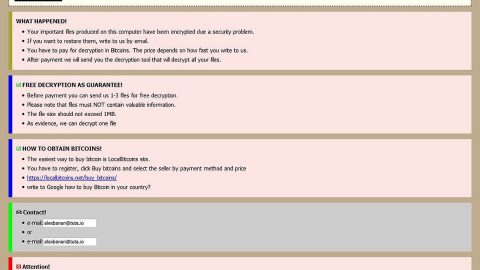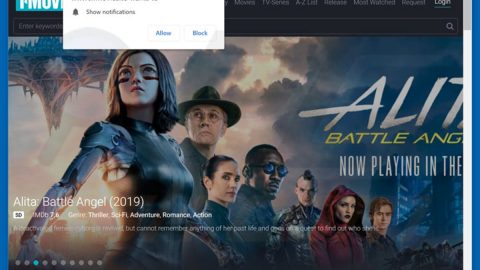What is “Dangerous try to get an access to your personal logins” scam? And how does it work?
“Dangerous try to get an access to your personal logins” scam is another bogus alert that suddenly pops up when you click on some ads while browsing the web. This deceptive alert is displayed on malicious websites and is trying to scare users into thinking that something dangerous is trying to get an access to their personal logins and bank information to track their browsing activities and that users have to call a given tech support number (+1(844)243-2014) that supposedly is a toll free number. If you are one of the users who keep seeing this fake alert, know that this alert does not hold any truth to it and is mainly a ploy to get you to call the fake tech support number. When you get redirected to the website displaying this deceptive alert, you’ll see the following message on your screen:
“There was a dangerous try get an access to your personal logins & bank information and to track your browser activity. Luckily, your Firewall managed to block this suspicious connection. We recommend you to freeze your account until some measures will be taken. There is a great threat of leaking of your personal data. So, you need to respond swiftly! Trojan Virus may have already hurt your hard disk and its data. That is why we are checking and verifying your current system security. Do now waste your time and consult one of our service centers or call us. Contact Number +1(844)243-2014 (TOLL-FREE) Your urgent response is needed. To deal with this problem, contact our network administration. We would ask you not to open your browser until the problem will be solved in order not to become a victim of the data corruption. You can contact our customer service department at +1 (844) 243-2014. Info about the virus. Acting as a backdoor, a Trojan horse virus can easily contact a controller and get a free access to the computer, which is under attack. It is not that easy to detect the Trojan and its backdoors.”
If you notice this fake alert is popping out of nowhere on a regular basis, then there is most likely an ad-supported program or adware installed on your system. Adware programs are known to trigger such fake alerts so you might have to look closely at the installed programs in your computer and see which one of them is the adware behind the scam. As long as the adware exist, you will have to endure seeing this fake alert so you need to get rid of the adware to completely get rid of the scam alert as well.
How does “Dangerous try to get an access to your personal logins” scam travels the web?
As mentioned, you can get redirected to this tech support scam when you click on some ads or when an adware is present in your system. Adware programs travel the web in software bundles found on free sharing sites. It can infiltrate your system if you’re not careful with the installation.
Use the removal guide below as a reference in removing the “Dangerous try to get an access to your personal logins” scam.
Step 1: If the browser is forced into a full-screen mode where “Dangerous try to get an access to your personal logins” is being displayed, tap F11 to exit your browser.
Step 2: After that, try to close the browser manually. If you find it hard to do so, close the browser through the Task Manager.
Step 3: Tap the Ctrl + Shift + Esc keys to launch the Task Manager.
Step 4: Once you’ve pulled up the Task Manager, go to the Processes tab and look for the affected browser’s process and end it by clicking End Task or End Process.

Step 5: Close the Task Manager and tap the Win + R keys to open Run and then type in appwiz.cpl to open Control Panel to uninstall the adware program behind the fake alert.
Step 6: Look for the adware program or any unfamiliar program under the list of installed programs and once you’ve found it, uninstall it.

Step 7: Close the Control Panel and tap the Win + E keys to open File Explorer.
Step 8: Navigate to the following directories and look for the adware installer like the software bundle it came with as well as other suspicious files and delete them.
- %USERPROFILE%\Downloads
- %USERPROFILE%\Desktop
- %TEMP%
Step 9: Close the File Explorer and empty your Recycle Bin.
Step 10: Reset all your browsers to default.
Internet Explorer
- Launch Internet Explorer.
- Tap Alt + T and select Internet options.
- Click the General tab and then overwrite the URL under the homepage section.
- Click OK to save the changes.
- Now switch to the Advanced tab and click the Reset button.
- Then check the box for “Delete personal settings” and then click Reset again.
Google Chrome
- Launch Google Chrome, press Alt + F, move to More tools, and click Extensions.
- Look for any unwanted add-ons, click the Recycle Bin button, and choose Remove.
- Restart Google Chrome, then tap Alt + F, and select Settings.
- Navigate to the On Startup section at the bottom.
- Click on Advanced.
- After that, click the Reset button to reset Google Chrome.
Mozilla Firefox
- Open the browser and tap Ctrl + Shift + A to access the Add-ons Manager.
- In the Extensions menu Remove the unwanted extension.
- Restart the browser and tap keys Alt + T.
- Select Options and then move to the General menu.
- Overwrite the URL in the Home Page section.
- Tap Alt + H to access Help.
- Next, select “Troubleshooting information” and click “Refresh Firefox” at the top of the page.
- Now click “Refresh Firefox” again to confirm the reset.
To make sure that you’ve successfully gotten rid of “Dangerous try to get an access to your personal logins” scam as well as the adware program behind it, you need to use an efficient program like [product-name]. To use it, follow the advanced steps below:
Perform a full system scan using [product-code]. To do so, follow these steps:
- Turn on your computer. If it’s already on, you have to reboot
- After that, the BIOS screen will be displayed, but if Windows pops up instead, reboot your computer and try again. Once you’re on the BIOS screen, repeat pressing F8, by doing so the Advanced Option shows up.
- To navigate the Advanced Option use the arrow keys and select Safe Mode with Networking then hit
- Windows will now load the SafeMode with Networking.
- Press and hold both R key and Windows key.
- If done correctly, the Windows Run Box will show up.
- Type in the URL address, [product-url] in the Run dialog box and then tap Enter or click OK.
- After that, it will download the program. Wait for the download to finish and then open the launcher to install the program.
- Once the installation process is completed, run [product-code] to perform a full system scan.













